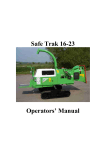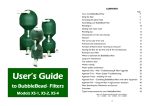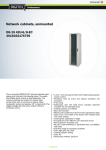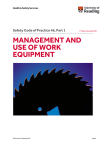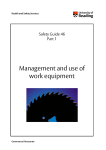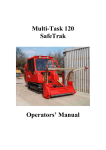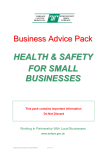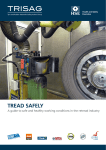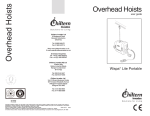Download SAFE-Trak 19-28 Mk2 Operators' Manual
Transcript
SAFE-Trak 19-28 Mk2 Operators’ Manual SAFE-Trak 19-28 Mk2 CONTENTS SECTION: 1 1. Introduction and Purpose 2. Technical Specifications, Dimensions and Noise Level 3. Safety and Symbols 3.1 3.2 3.3 3.4 3.5 3.6 3.7 3.8 Ensure! Never! Always! Safety controls and switches Control cut-outs 'No Stress' system Tracking controls Symbols 4. Machine Preparation 4.1 4.2 4.3 Fuelling and parking Infeed chute Discharge chute 5. Operation 5.1 5.2 5.3 5.4 5.5 5.6 5.7 5.8 Pre-work checks Starting machine Moving machine Starting Chipper Stopping Chipper Adjustable Feed roller control Operating Hints On Completion of Work 6. Maintenance For Engine and Tracks please refer to separate manuals 6.1 6.2 6.3 6.4 6.5 6.6 6.7 6.8 6.9 6.10 6.11 Routine Maintenance schedule Engine Oil Coolant Hydraulic Oil Fuel level Drive Belts Disc Blades Radiator Steam Cleaning Air Cleaner Electrical Connections ©GreenMech Ltd -1- 12/09 SAFE-Trak 19-28 Mk2 CONTENTS 6.12 6.13 6.14 6.15 6.16 6.17 6.18 6.19 6.20 6.21 6.22 6.23 2 Battery Bearings and pivots Chipper Drive belt tension Track Pump Drive Belts Hydraulic connections Mountings Hydraulic Return Filter Track removal Hydraulic Oil change Fuses and No Stress system Fault finding chart Blade sharpening 7. Storage 7.1 7.2 Storage Removal from storage 8. Disposal 9. Appendix 9.1 9.2 9.3 9.4 Hydraulic Circuit Electrical Circuits Certificate of Conformity Risk Assessment ©GreenMech Ltd -2- 12/09 SAFE-Trak 19-28 Mk2 1. INTRODUCTION AND PURPOSE 1-1 INTRODUCTION This manual explains the proper operation of your machine. Read these instructions thoroughly before operating and maintaining the machine. Failure to do so could result in personal injury or equipment damage. Consult your GreenMech supplier if you do not understand the instructions in this manual. CAUTION! This symbol indicates important safety messages in this manual. When you see this symbol, be alert to the possibility of injury to yourself or others, and carefully read the message that follows. We recommend that you keep this manual with the machine in the box provided. Note here the serial number and quote it in any communications. This is important when ordering spares. Remember to include all numbers and letters. Serial Number................... Serial Number Write in the number! This manual covers the following engine driven self-propelled SAFE-Trak models. SAFE-Trak 19-28 Mark2 Optional winch and optional Lighting post - see supplement sheet for instructions. If in doubt, always quote the serial number in any communications. The information in this manual is correct at the time of publication. However, in the course of development, changes to the machine specification are inevitable. Should you find any information to vary from the machine in your possession please contact your GreenMech dealer for up to date information. The manual may contain standard and optional features and is not to be used as a machine specification. PURPOSE CAUTION! This machine is designed solely to chip wood and must not be used for any other purpose. The machine should only be used by trained operators who are familiar with the contents of this instruction manual. It is potentially hazardous to fit or use any parts other than genuine GreenMech parts. These Wood Chippers are for Off Highways use only. The company disclaims all liability for the consequences of such use, which in addition voids the machine warranty. ©GreenMech Ltd 1-1 09/13 SAFE-Trak 19-28 Mk2 2 SPECIFICATIONS 2-1 Fig 2.1 SAFE-Trak 19-28 Mk2 Discharge Chute Chipper Disc Cover Tracking Controls Control Bar Engine Cover Reset Knob Feed Roller Pivot Infeed Chute Track Leg TECHNICAL SPECIFICATION SAFE-Trak 19-28MT50 Mk1 Max capacity 190mm x 280mm (7.5inch x 11inch) Infeed opening 1200mm x 840mm Throat size 190mm x 280mm Chipping disc 600mm x 25mm Speed 1500 rpm Chipping disc-blades 4 Discs Feed rollers 2 x Hydraulic & Spring Tensioned Power control No-Stress Electronic Feed Roller Controller Power unit 50hp water cooled diesel Fuel capacity 60Lt Hydraulic capacity 50Lt Length (maximum in work position) 4150mm Length (minimum for transport) 3550mm Width over body 1320mm Track width 1200mm – 2012mm Track size 250mm x 1768mm Height 2390mm – 2720mm Weight 2000Kg Ground pressure 0.26kg/cm2 ©GreenMech Ltd 2-1 12/09 SAFE-Trak 19-28 Mk2 2 SPECIFICATIONS 2-2 Noise Noise levels vary depending on type of material being processed. Also duration of operation is variable. Noise emission tests have been carried out and the guaranteed sound power level is displayed on the CE plate as follows: Lwa 120dB Minimise noise by switching to idle or stopping the engine whenever chipping is not in progress. Full details are included in the Risk Assessment in the Appendix. CAUTION! Operators must wear appropriate ear protection. Bystanders must be kept away from proximity of machine. Lifting Points Two lifting point are on each side of machine and tie-down anchor points are on each corner of the chassis (fig 2.2). Fig 2.2 Lifting Points on both sides of machine Lift points Tie down points ©GreenMech Ltd 2-2 12/09 SAFE-Trak 19-28 Mk2 3. SAFETY 3.1 ENSURE: 3.1.1 All Operators must be fully trained in the use of their machine. (Certificated Operator training courses are available on request.) 3.1.2 The Operators Manual is read and understood. 3.1.3 The enclosed HSE guidance notes are read and understood. 3.1.4 Appropriate Personal Protective Equipment (PPE) is worn, including nonsnag clothing, gloves, eye and hearing protection. 3.1.5 These Wood Chippers are for Off Highways use only. 3.1.6 The machine is positioned with the body level. 3.1.7 The infeed chute (bottom control bar) at least 600mm (23.62 inches)above ground level (fig 3.1) . 3.1.8 All guards are fitted and in good condition. 3.1.9 Blades are in good condition and secure. 3.1.10 All blades are sharpened or replaced in “Sets”. 3.1.11 All fasteners are checked regularly for tightness. 3.1.12 Only “WOODEN” materials free of nails etc., are fed into the machine. 3.1.13 Correct First Aid Kit including large wound dressing is available on site. 3.1.14 Fire extinguisher is available on site. 3.2 NEVER: 3.2.1 Work on the machine until the chipper disc is stationary and engine or PTO has stopped. 3.2.2 Operate the machine without protective clothing (Eye protection, Earmuffs, and Gloves), or high visibility clothing when working on roadside. 3.2.3 Operate with loose articles of clothing, including loose cuffs on gloves. 3.2.4 Work under a raised component without adequate safety support. ©GreenMech Ltd 3-1 3-1 3.2.5 Operate the machine with untrained personnel or with individuals present who are not involved in the chipping operation. 3.2.6 Leave the machine unattended with engine running at full operating speed. (See section 4) 3.2.7 Put any part of your body into the infeed chute while the machine is running. 3.2.8 Operate the machine whilst under the influence of alcohol or drugs. 3.2.9 Stand between the tracks and the chipper body. 3.2.10 Stand within 2 metres of the tracks when the legs are being extended. 3.2.11 Extend legs to put the tracking controls beyond reach. 3.2.12 Stop the engine or operate the chipper when moving directly up or down a slope. 3.2.13 Operate inside a building or confined space. 3.2.14 Climb on the infeed chute. 3.2.15 Impede or obstruct the Stop control. 3.3 ALWAYS: 3.3.1 Check machine before starting (see Section 4 Preparation and Section 5.1 Operation: Pre-work checks). 3.3.2 Be aware of potential hazards in the work area, i.e. uneven ground, tree roots, obstructions and type of materials being fed into the machine. 3.2.3 Feed from the side. 3.3.4 Keep clear of discharge area. 3.3.5 Have a second trained operator within easy reach of the machine. 3.3.6 Maintain strict discipline at all times. 3.3.7 Service machine at specified periods. (see Section 6: Routine Maintenance). 3.3.8 Note direction of discharge chute and if necessary note the wind direction to prevent debris from being blown into highway or where it could affect members of the public. 3.3.9 Adjust legs to keep the body level. 3.3.10 Check the route to the worksite for gradients, undulations and obstructions. 3.3.11 Remove key before doing any maintenance. 02/11 SAFE-Trak 19-28 Mk2 3. SAFETY 3-2 Fig 3.4.1 Bottom Control Bar, Reset Knob, and emergency Stop 3.4 Safety Controls and Switches 3.4.1 Emergency Stop/Control Bar (fig 3.4.1) In the event of an emergency, push the emergency stop bar to STOP the feed rollers. 3.4.1.1 Once the emergency has been rectified the following sequence should be carried out: 3.4.1.2 To restart rollers press either reset knob. 3.4.1.3 Should the stop bar be tripped accidentally in normal working conditions i.e. NOT an emergency, then the rollers can be recovered by performing the above sequence. 3.4.1.4 To reverse (Feed Out) the rollers push the control bar into the middle detent. To regain forward (Feed In) pull the control bar away from the chipper. It is not necessary to use the reset knob. Control bar Reset knob (both sides) Idle/Run knob Control Bar positions (Viewed towards right of chute) FEED IN FEED OUT STOP (Viewed towards left of chute) STOP FEED OUT FEED IN Fig 3.4.2 Engine STOP RDS Controller CAUTION! Regularly check that the bar locates in the 3 correct positions. At no time may this system be removed, jammed, disabled or otherwise impede from effecting the infeed stop control. STOP Hand Throttle 3.4.2 Engine stop switch Press STOP button (fig 3.4.2) and wait for engine to stop, before turning key (fig 3.4.3) to OFF Fig 3.4.3 Key and battery isolator CAUTION! Do not restart engine until hazard has been removed. Key Note: Refer to Operation paragraph 5.5 for normal stopping procedure. 3.4.3 Battery isolator (fig 3.4.3) Turn switch to OFF Battery Isolator ©GreenMech Ltd 3-2 02/11 SAFE-Trak 19-28 Mk2 3. SAFETY 3-3 3.5 Control cut-outs Cut-outs are installed to stop and prevent restarting due to specific events. 3.5.1 Engine overheating is protected by thermal cut-out switch in coolant circuit. 3.5.2 Low engine oil pressure is protected by pressure switch in the engine oil pump. 3.5.3 Engine cover opening is protected by a microswitch to shut off the fuel solenoid. 3.6 No Stress system 3.6.1 Speed sensor in alternator disables feed roller FEED IN mode when engine speed is below factory pre-set value. LED light glows Green at normal operating speed, Red at overload and idle and Red Flash when start switch turned on. Fig 3.7 Track Controls Track controls 3.7 Tracking Controls (Fig 3.7) 3.7.1 A two position toggle switch selects either tracking or chipping. In track mode the No Stress system will not allow the feed rollers to operate. In chip mode the legs cannot be extended and the drive to the track pumps is disconnected. (Fig 3.7) 3.7.2 A three position switch controls each extending leg. Press in desired direction. 3.7.3 Lever controls operate the drives to the tracks. Push for forward motion. Pull for reverse motion. 3.7.4 A hand throttle (fig 3.4.2) is fitted for use only when the machine is being tracked, not when chipping. Note: The chipper disc runs whenever the engine is running. Leg Switches Chip - Track ©GreenMech Ltd 3-3 02/11 SAFE-Trak 19-28 Mk2 3. SAFETY 3-4 3.8 SYMBOLS on the MACHINE These relate to operator safety, correct use and maintenance of machine. Check that all personnel understand and are familiar with meanings before using the machine. Important Safety symbols Take the correct action shown on the display below the stated hazard (see table) General Safety Caution! Do NOT start engine Remove key Caution! Beware flying object hazard Beware noise hazard Beware trapping hazard Brakes off -incorrect Read instruction manual Wear helmet & visor Wear ear protectors Wear proper clothes Brakes on -correct Machine not level -incorrect Beware flying object hazard Beware exposed drives hazard Caution! Machine level -correct Keep bystanders away Fit all guards Keep nuts tight Beware flying object hazard Position and lock discharge chute Important Operating Checks Notice Before use carry out daily the stated checks in the order shown (see table) Daily Checks Every 8 Hours – Daily checks ©GreenMech Ltd Remove key stop engine 1. Check coolant level 2. Check engine oil level 3. Check hydraulic oil level 4. Check machine is level 5. Check brakes are on 6. Check chipper disc is clear of debris 7. Check all guards are in place 8. Check infeed chute is clear of debris 9. Lock discharge chute 10. Pull control bar to work position 11. Start engine 12. Increase from Idle to Run 3-4 02/11 SAFE-Trak 19-28 Mk2 3. SAFETY 3-5 Important Safety Information Caution! Do NOT drive up or down slopes of more than 25° Caution! Beware Crushing hazard! Caution! Do NOT operate or traverse on slopes of more than 35° Do NOT work or park directly up or down slope. Caution! Beware crushing hazard Caution! Beware of thrown object hazard Action: Do NOT stand in area between machine body and tracks Action: Keep away from fast discharge chute Caution! Ear defenders must be worn Face shield must be worn Do NOT operate with infeed chute at less than 600mm from ground. (bottom bar machines) ©GreenMech Ltd 3-5 02/11 SAFE-Trak 19-28 Mk2 3. SAFETY 3-6 Safety Information (continued) Caution! Beware of thrown object hazard Transport Lock Sound level Ear defenders must be worn Action: Stand to side of infeed chute, NOT in centre. Caution! Lift Point Lock this component before moving machine Caution! Infeed chute trapping hazards Do not climb into infeed chute Keep hands clear. Do not climb in Maintenance Information Radiator cleaning Diesel Filler Grease point 40 hours / weekly Hydraulic Filler 8 Hours Check radiator screen ©GreenMech Ltd High temperature grease 40 hours 40 Hours Blow out radiator core 3-6 02/11 SAFE-Trak 19-28 Mk2 3. SAFETY 3-7 Operating Information Track drive and throttle controls Track – Chip controls Track legs Outer switches – legs extend - retract Centre switch – Up to chip: Down to drive Discharge chute control Left lever LH track: forwards – backwards Right lever RH track: forwards – backwards Lever with red knob Engine throttle slow - fast Green is UP Blue is DOWN Reset lever: Left hand shown Bottom type Control Bar. Left hand shown Push to STOP : Centre-feed out : Pull–feed in ©GreenMech Ltd 3-7 Pull to reset 02/11 SAFE Trak 19-28 Mk2 4 MACHINE PREPARATION 4-1 4.1 Initial Fuelling and Parking Fig 4.1 Hydraulic tank valve 4.1.1 Fill the fuel tank with diesel. See section 6. 4.1.2 Top up the hydraulic tank if necessary, with the correct oil. See Section 6. Hydraulic tank valve CAUTION! Ensure that hydraulic tank valve (Fig 4.1) is set and locked to Open. Failure to do so will damage components. 4.1.3 Position the machine body level and adjust until the infeed chute is in correct position - 600mm min from the ground. (see fig 3.1) Fig 4.2 Infeed chute catch. Catch (transport) 4.2 Infeed Chute unfolding 4.2.1 Remove the transport pin for the infeed chute catch, release the catch (fig 4.2) 4.2.2 Using the tubular edge as a handle, lower the infeed chute to the work position and reset the catch. 4.2.3 Measure the height of the infeed chute and readjust the legs as required. CAUTION! The infeed chute must be positioned correctly above the ground. (fig 3.1) CAUTION! Before travelling, always fold up and secure the infeed chute. 4.3 Discharge Chute (Fig 4.3) 4.3.1 Release the swivel clamps and point the chute in the desired direction, always pointing away from the infeed. 4.3.2 Set the flap at the desired height and tighten the flap lever clamp. Catch (work) CAUTION! When travelling, lock the discharge chute pointing away from the driver. Fig 4.3 Discharge chute Flap lever Swivel clamps ©GreenMech Ltd 4-1 02/11 SAFE-Trak 19-28 Mk2 5. OPERATION 5-1 5.1 Pre-Work Checks: 5.1.1 Check machine is stationary, start key removed, 5.1.2 Check that machine is level and infeed chute is set at correct height. (fig 3.1). 5.1.3 Check engine oil level (Refer to engine instruction manual). 5.1.4 Check hydraulic oil level (See Section 6). 5.1.5 Check fasteners for tightness and hydraulic connections for leaks. 5.1.6 Check condition of disc blades. 5.1.6.1 Raise or remove engine cover. 5.1.6.2 Remove the bolts retaining chipper disc cover. (Fig 5.1) 5.1.6.3 Using discharge chute handle as a lever, swing back cover onto stop to expose chipper disc and blades. (fig 5.1) 5.1.6.4 Carefully rotate chipper disc to check tightness of disc blade bolts and condition of blades. 5.1.6.5 Remove any loose wood material. 5.1.6.6 If any bolts are loose, refer to maintenance section 6 for further action. 5.1.6.7 Replace chipper disc cover and tighten bolt(s) securely. 5.1.7 Remove any loose material and dust from radiator and engine bay. 5.1.8 Replace engine cover. 5.1.9 Check discharge chute is in desired position and all clamps are tight. (see Section 4.3) 5.1.10 Check infeed chute (fig 4.2) is locked in position with catch. 5.1.11 Check work area and erect signs and cone off discharge area if necessary. 5.1.12 Check ALL safety procedures have been followed. Fig 5.1. Chipper Disc Cover Bolts CAUTION! Beware sharp edges of discs and unexpected movement. CAUTION! Always work with the chipper level across a slope, preferably with the infeed direction slightly down the slope to minimise the risk of material falling back out. ©GreenMech Ltd 5-1 02/11 SAFE-Trak 19-28 Mk2 5. OPERATION 5-2 Fig 5.2.1 Key and battery isolator 5.2 Starting Machine (RDS Control): 5.2.1 Check all other personnel are clear of machine. 5.2.2 Check that feed roller control bar is pushed to the FEED OUT or STOP position, to make the machine safe. 5.2.3 Check that battery isolator (fig 5.2.1) is ON. 5.2.4 Turn the ignition key to ON position. 5.2.5 When 0000 appears enter PIN code at RDS box (fig 5.2.2) as below. Note: This feature may not be enabled. Please consult your dealer for instructions to enable or disable PIN, according to preference. 5.2.5 1 Press and hold left hand menu button until first digit of PIN is displayed. 5.2.5.2 Release button and repeat for second and remaining digits until code is entered. 5.2.5.3 When code is correct press SET. 5.2.6 Wait for the pre-heat icon to disappear. 5.2.7 Press and hold START button until engine is running. 5.2.8 Increase speed to operating speed by slow/fast to FAST (hare) switch or hand throttle lever if fitted. Key Battery Isolator Fig 5.2.2 RDS control box Slow/Fast speed Set STOP Start Menu ©GreenMech Ltd 5-2 02/11 SAFE-Trak 19-28 Mk2 5. OPERATION 5-3 5.3 Moving the Machine 5.3.1 At tracking controls, (fig 5.3.1) select Track. (Centre switch down) 5.3.2 Extend legs as required, keeping body level. (fig 5.3.2) 5.3.3 Push both levers forwards together to start forward movement. 5.3.4 Open hand throttle to increase speed. Close to decrease speed. 5.3.5 Push left or right lever to steer. 5.3.6 At work site adjust legs to level the body and to position infeed chute at 600mm min. height. 5.3.7 Close hand throttle to slow engine. Note: When extending or retracting legs it is advisable to track the machine. Fig 5.3.1 Tracking Controls Motion levers Leg Switches Hand throttle CAUTION! When extending legs, do not force track against solid objects. This may dislodge track. Fig 5.3.2 Track Legs CAUTION! Avoid static turns on hard surfaces. This will rapidly wear the tracks CAUTION! Point the discharge chute away from the driver. Over long journeys, engage the chipper drive to blow out build up of exhaust gas. Body level CAUTION! Do not drive directly up slopes exceeding 20 degrees. Slopes up to 35 degrees may be traversed with care. ©GreenMech Ltd 5-3 02/11 SAFE-Trak 19-28 Mk2 5. OPERATION 5.4 Starting the Chipper 5.4.1 At tracking controls, select CHIP. (Centre switch up) 5.4.3 Press Hare on control unit (fig 5.2.2) or yellow button on infeed chute (fig 3.4.1) to increase speed to operating speed. 5.4.4 Push the reset knob to release the control bar for work. (Fig 3.4.1) Fig 5.4 RDS Control unit display. Disc speed 1470 minimum 5.5 Stopping the Chipper 5.5.1 Push the control bar to STOP position. 5.5.2 Set hand throttle lever to Idle. 5.5.3 Press SLOW (tortoise) on control unit and allow chipper disc to slow down. 5.5.4 Press STOP to stop the engine (fig 5.2.2). 5.5.5 Switch start key to OFF to stop the engine. Note: Use of start key to OFF will require re-entry of PIN code, if enabled. 5.5.6 Always wait for chipper disc to stop. Fig 5.6 Adjustable feed roller control 5.6 Adjustable Speed Feed Roller Control When chipping wood sizes larger than 150mm diameter it is necessary to reduce the feed roller speed to suit the material being chipped. The control knob can be carefully accessed from inside the battery cover. 5.6.1 Turn the valve control knob (fig 5.6) clockwise until valve is closed. 5.6.2 Turn the knob anticlockwise to the recommended setting in the table. 5.6.3 Close the cover and secure. Control Knob Control knob settings Material Setting up to 150mm Fully open (3 turns) 150 - 250mm 1/2 to 3/4 turn ©GreenMech Ltd 5-4 5-4 02/11 SAFE-Trak 19-28 Mk2 5. OPERATION 5-5 5.7 Operating Hints 5.7.1 Check chip/track switch is set to CHIP. 5.7.2 Check disc speed on control unit is 1470rev/min minimum or more (fig 5.4). NOTE: The “No Stress” system will only allow FEED IN (Forwards) operation of the feed rollers when the machine is running at FULL operating speed. 5.7.4 Select IDLE to reduce speed from RUN to IDLE whilst further material is collected for chipping. 5.7.5 Take care when feeding wood into the machine to allow for awkward shapes to “KICK” when contacting the feed rollers. 5.7.6 Position the end of larger sections of wood inside the infeed chute and then support the other end whilst pushing the wood into the feed rollers. CAUTION! Do not release discharge chute clamps when chipping is in progress. Elevation of the discharge is altered by means of the adjustable flap (fig. 4.3). CAUTION! Keep working area around the machine clear at all times and check only authorised personnel are present. Fig 5.8 Transport Position 5.8 On Completion Of Work 5.8.1 Check that engine has stopped and chipper disc is stationary. 5.8.2 Remove surplus material from infeed chute and machine surfaces. 5.8.3 Fold infeed chute to transport position using control bar, secure with lock and fit locking pin. 5.8.4 Set discharge flap into lowest position and tighten clamp. 5.8.5 Release clamps, turn discharge chute to straight position away from tracking controls, tighten clamps. CAUTION! Do not leave machine parked directly up or down slope. ©GreenMech Ltd 5-5 02/11 SAFE-Trak 19-28 Mk2 5. OPERATION 5.9 RDS Control Display Control displays chipper speed (default), feed roller status, daily hours, total hours and faults. (Fig 5.9) 5.9.1 Press left hand menu button to scroll through display menu indicated by black triangle over symbol. 5.9.2 Reset daily hours. Scroll to daily hours (pos. 5) Press and hold Set/Reset. 5.9.3 Fault signals. Refer to Maintenance section 6.23. Fig 5.9 RDS control box Idle/Fast speed Set CAUTION! Bleep sounds. Ten regular bleeps indicates engine service due. Bleeps at other times may indicate a fault. If in doubt, consult dealer. STOP Start CAUTION! Do not hang other keys with ignition key. Weight can stop engine. Menu ©GreenMech Ltd 5-6 5-6 02/11 SAFE-Trak 19-28 Mk2 Options - Winch and Lighting Post S-1 HAULAGE WINCH A winch for haulage is installed under the infeed chute and can be used with chute folded or unfolded. Refer to winch instructions for safe use and maintenance. LIGHTING POST Fig 2 Work position – post raised Fig 1 Transport position – post stowed Preparation (see Figs 1 and 2) 1.1 Remove pin from support above engine cover. 1.2 Using winch, partially raise post to enable extension to clear control levers. 1.3 Remove extension pin and extend post to full length (5 holes exposed) (Fig 2) taking care of cable, and re-insert pin to secure. 1.4 Using winch (Fig 3), raise post to vertical and secure upright with pin. 1.5 On completion of work, reverse procedure and secure with all pins for transport (Fig 1) Operation. Turn switch on (Fig 4). Fig 4 Lighting post pins Fig 3 Lighting post installation Pin Winch Extension Pin Switch Winch Maintenance Refer to component suppliers’ instructions. ©GreenMech Ltd S-1 09/13 SAFE-Trak 19-28 Mk2 6. MAINTENANCE 6-1 ROUTINE MAINTENANCE SCHEDULE CAUTION! Always remove key and check for rotation before carrying out any maintenance. All covers except engine cover are secured closed with bolts requiring a spanner. Action DAILY Check engine oil level and coolant (ref: engine manual) Check hydraulic oil level Check fuel level Check all drive belts Check condition of disc blades and retaining bolts Clean radiator screen and around radiator Check feed roller control bar function Check condition of tracks Check track gear, nuts, rollers and bearings 6.2 – 6.3 6-6 6.4 6-6 6.5 6-7 6.6 6-7 6.7 6-8 6.8 6-9 3.4 3-2 Refer to track manual Refer to track manual FIRST 50 HOURS Check battery levels Check drive belt tensions Check hydraulic connections Check all mountings Check feed roller control bar function Service engine 6.12 6-10 6.14 6-10, 6-11 6.16 6-12 6.17 6-12 3.4 3-2 Refer to engine manual WEEKLY in addition to Daily actions Grease all bearings, pivots and slide pads Blow out radiator core with air line Steam clean machine Clean air cleaner Check electrical connections Check battery levels Check chipper and pump drive belt tensions Check hydraulic connections Check all mountings Check feed roller control bar function 6.1, 6.13 6.8 6.9 6.10 6.11 6.12 6.14, 6.15 6.16 6.17 3.4 250 hours in addition to Daily and Weekly actions Check condition of bearings and pivots Check all fluid levels Service engine Check track gear units, rollers and bearings Replace return filter element(s) 6.1, 6.13 6-5, 6-10 6.2, 6.3, 6.4 6-6 Refer to engine manual Refer to track manual 6.18, 6.19 6-13 1000 hours in addition to 250 hour actions Change hydraulic oil when replacing filter element 6.20 ©GreenMech Ltd 6-1 Section Page 6-5, 6-10 6-6 6-9 6-9 6-9 6-10 6-10, 6-11 6-12 6-12 3-2 6-14 02/11 SAFE-Trak 19-28 Mk2 6. MAINTENANCE 6-2 DIESEL ENGINE MAINTENANCE REFER TO ENGINE MANUAL TRACK MAINTENANCE REFER TO TRACK MANUAL Recommended lubricants Hydraulic Oil Grease Engine Specification ISO 32 Complex grease EP2 SAE 15W-40 APICD (high temperature) 6.1 Lubrication Points (see also 6.13) Fig 6.1 Lubrication points SAFE-Trak 19-28 Mk2 6.1.5 6.1.3 6.1.4 6.1.2 6.1.6 6.1.1 6.1.7 6.1.8 Grease except where stated 6.1.1 Track legs 2 nipples each leg 6.1.2 Top Feed roller pivot 1 nipple 6.1.3 Top Feed roller bearing 1 nipple 6.1.4 Chipper Disc front bearing 1 nipple 6.1.5 Chipper Disc rear bearing 1 nipple 6.1.6 Infeed chute hinges Oil 6.1.7 Infeed roller mechanism Clean and grease 6.1.8 Bottom Feed roller bearing 1 nipple Note. Do not overgrease bearings as damage to seals may occur. Note: Use high temperature grease on chipper disc bearings ©GreenMech Ltd 6-2 02/11 SAFE-Trak 19-28 Mk2 6. MAINTENANCE 6-3 Fig. 6.2 Engine dipstick 6.2 Engine Oil 6.2.1 Check daily (fig 6.2). Refer to engine manual to refill. Dipstick 6.3 Coolant 6.3.1 Check daily, both radiator and overflow tank (fig 6.3). Refill as required. Check antifreeze. CAUTION! Do not remove cap when engine is hot. Fig.6.3 Coolant Filler 6.4 Hydraulic Oil 6.4.1 Check daily (fig 6.4). If below mark check for leaks and refill to correct level. Expansion filler 6.5 Fuel 6.5.1 Check daily (fig 6.5) before work and fill with diesel as required. Fig 6.4. Hydraulic Filler/Filter CAUTION! Use clean diesel fuel only. If in doubt, use a funnel with a filter. Filler/filter CAUTION! Do not use any form of synthetic fuel. 6.6 Drive Belts 6.6.1 Check daily, before work, the condition of all drive belts and replace if worn. See section 6.14 and 6.15 Fig 6.5 Fuel Filler Fuel Filler ©GreenMech Ltd 6-3 02/11 SAFE-Trak 19-28 Mk2 6. MAINTENANCE 6-4 6.7 Disc Blade Rotation and Replacement The design of the blades permits relocation in at least three rotated positions before regrinding or replacement is required. 6.7.1 Check engine is switched off, and start key removed. 6.7.2 Raise engine cover, and check any rotation has stopped. 6.7.3 Remove the bolts retaining chipper disc cover (fig 5.1 and fig 6.7). Fig 6.7 Chipper Disc CAUTION! Take care. Blades are extremely sharp. Torque to 150Nm CAUTION! Beware sharp edges of discs and unexpected movement. 6.7.4 Using discharge chute handle as a lever, swing back cover on to stop to expose chipper disc and blades. 6.7.5 Current best practice is to ‘lock’ chipper disc with timber or similar in desired position when slackening or tightening blade bolts to 150NM. 6.7.6 Slacken disc blade retaining bolt, remove disc, clean mounting face and location. 6.7.7 Replace disc in a rotated position to present a sharp section to the shear bars. 6.7.8 Torque up bolt to 150NM (110lb.ft.) 6.7.9 Check condition and security of shear bars. Rotate or replace if required. Do not regrind. CAUTION! Disc blades must only be sharpened by grinding the angled back face on a suitable grinder. Grinding of the front face will upset the gap, which is factory set. Do not sharpen with hand held equipment. Note. If any of the Disc-Blades are worn below the flat annular section a complete set should be replaced. Inspect condition of nuts and bolts and replace if any signs of wear. All blades must be sharpened in “sets” with equal amounts removed to maintain balance. See section 6.23 for disc grinding details ©GreenMech Ltd 6-4 02/11 SAFE-Trak 19-28 Mk2 6. MAINTENANCE 6-5 6.8 Radiator Daily 6.8.1: Blow radiator core from front. (fig 6.8) Fig 6.8 Radiator CAUTION! A build up of debris risks overheating of the engine and a risk of fire. Blow from rear 6.9 Steam Cleaning 50 hours 6.9.1 Check all covers are fitted and closed. 6.9.2 Steam clean machine surfaces. 6.9.3 Clean electrical components with a damp rag, spray with WD40 and then wipe with dry rag. CAUTION! Do not steam clean directly on to electrical components, e.g. control boxes. Fig 6.10 Air Cleaner 6.10 Air Cleaner 50 hours 6.10.1 Release wingnut or clip and remove cover (fig 6.10). 6.10.2 Release wingnut, slide out element and either blow out with air-line or gently tap on smooth ground to release debris. If badly contaminated replace element. 6.10.3 Replace and tighten wingnut fingertight. 6.10.4 Replace cover. Cover screw 6.11 Electrical connections 50 Hours 6.11.1 Check all wiring loom connections are secure. CAUTION! Poor connections will affect engine security cut-outs and may prevent starting. ©GreenMech Ltd 6-5 02/11 SAFE-Trak 19-28 Mk2 6. MAINTENANCE 6-6 6.12 Battery (fig 6.12) 50 hours 6.12.1 Turn isolator (fig 5.2.1) to OFF 6.12.2 Check electrolyte level and top up if required 6.12.2 Turn isolator to ON. Fig 6.12 Battery Battery CAUTION! Gases are explosive. Electrolyte is corrosive. Avoid sparks and spillage. 6.12.3 Removal of battery 6.12.3.1 First disconnect negative (-) cable. 6.12.3.2 Disconnect positive (+) cable. 6.12.3.3 Remove clamp and carefully lift out battery. 6.12.3.4 Replace by connecting positive cable before negative. 6.13 Bearings and Pivots 50 hours See section 6.1 for routine lubrication. 250 hours 6.13.1 Check rotating components for excessive movement and noise in operation. 6.13.2 Replace as required. Fig 6.14 Belt tension release bar 6.14 Chipper Drive belt Tension Tensioning is automatic and does not require any routine attention. Belt Replacement 6.14.1 Screw special bar through side of machine (fig 6.14) to engage idler pulley bracket. 6.14.2 Continue to screw to push back bracket against spring force until the belts are sufficiently slack to remove. 6.14.3 Remove all belts and discard. 6.14.4 Fit new set of belts ensuring they lay snugly in grooves of all three pulleys. 6 14.5 Carefully unscrew bar and stow. 6.14.6 Check alignment and tension before starting chipper. Belt bar ©GreenMech Ltd 6-6 02/11 SAFE-Trak 19-28 Mk2 6. MAINTENANCE 6-7 6.15 Track pump drive belts 50 hours 6.15.1 Check tension. If belts are slack, tighten using adjuster bolt. (fig 6.15.1) Note: Spare belts may have been fitted over pump to reduce delay in emergency replacement. Fig 6.15.1 Track Pump Drive Belts 6.16 Hydraulic connections 50 hours then 250 hours 6.16.1 With the aid of the circuit diagram to follow the hose routings, check all hoses and connections for leaks and damage. 6.16.2 Replace any worn or damaged hoses with the correct type and length. 6.16.3 Before removal, check routing and ensure replacement hose is fitted free of strains, twists or kinks. 6.16.4 To prevent spillage on hose removal close the tank valve (fig 4.1) Adjuster bolts CAUTION! Ensure any residual pressure is released before dismantling. CAUTION! Ensure hoses are refitted free of twists and kinks. CAUTION! Ensure that hydraulic tank valve (Fig 4.1) is set and locked to Open before starting machine. Failure to do so will damage components. 6.17 Mountings 50 hours then 250 hours 6.17.1 Check that all mounting bolts are tight. Fig 6.18. Hydraulic Filler/Filter 6.18 Hydraulic Return Filter (Fig 6.18) 250 hours 6.18.1 Check oil is cool. 6.18.2 Unscrew the filter cover (there is a spring under the cover) and carefully lift out the element, it may require gentle prising out, discard safely (see section 8). 6.18.3 Fit a new filter element to the correct specification and replace the cover and spring. Filler/filter CAUTION! Do not overtighten. ©GreenMech Ltd 6-7 02/11 SAFE-Trak 19-28 Mk2 6. MAINTENANCE 6-8 6.19 Track removal A support leg (fig 6.19) enables individual track assemblies to be removed for servicing. 6.19.1 Extend both track legs. 6.19.2 Remove foot from parked position and fit to base of support leg. 6.19.3 Remove pin and reposition leg on side to be removed, with foot on firm ground. 6.19.4 Carefully retract track leg until clear of ground to remove. 6.19.5 Refer to track manual for servicing. Fig 6.19 Support leg - track removal Foot Leg (each side) Pin 6.20 Hydraulic Oil change 1000 hours 6.20.1 Remove hydraulic oil with suction pump at filler, or via drain plug on underside of tank and replace with new oil of correct specification. 6.20.2 Replace suction filter. 6.20.3 Dispose of waste oil according to local authority environmental procedures. 6.21 Fuses and No Stress system There are two fuses. 6.21.1 A 40 amp in-line fuse protects the engine pre-heat and start circuit. 6.21.2 A 20 amp fuse protects the No Stress system. Note The engine operating speeds for the No Stress system are factory set for particular machine builds and must not be readjusted. ©GreenMech Ltd 6-8 02/11 SAFE-Trak 19-28 Mk2 6. MAINTENANCE 6-9 6.22 Fault finding This machine is fitted with an RDS controller which can display various engine and machine faults: Fig 6.23 RDS Engine Control Engine faults 6.22.1 Engine faults. Black arrow at position 1: read-out COOL, OIL, or ALT Check relevant problem (e.g. coolant) and rectify as below. 6.22.2 To reset read-out, press and hold SET/RESET for 2 seconds. Press STOP for 2 seconds. Restart engine. 6.22.3 If fault still present, consult dealer. Fault Check Action Page Engine will not start Battery Recharge 6-10 Fuel Fill tank 6-7 Oil pressure Check Oil level 6-6 Thermal cut-out Check operation 3-2 Fuses Check 6-14 Engine not at correct speed Engine stops. Control display ‘COOL’ Engine stops. Control display ‘OIL’ Engine stops. Control display ‘ALT’ Clutch cut-out Radiator Oil level Alternator belt 5-3 6-9 6-6 No stress light not on Blade disc will not start Fuses, cut-outs Clutch Drive belts Chip/Track switch Control bar Hydraulics Control bar Hydraulic valve Discharge chute Blade disc Blade condition Track legs Blade disc and bearings Chip/Track switch Chip/Track switch Pump drive belts Hydraulics Check operation Check level and clean core Check and top up oil Check and adjust tension. See engine manual Check operation Adjust (STC220 only) Replace Select 'Chip' Reset and check Check solenoid valve Reset and check Check operation Check for blockage Check for blockage Replace with sharp blades Set to correct position Check and replace Select 'Track' Select 'Track' Check and adjust Check operation Feed rollers do not turn Feed will not reverse Discharge does not flow Wood unevenly chipped Machine unsteady Unusual noise(s) Track legs do not extend Tracks do not drive ©GreenMech Ltd 6-9 02/11 6-14 6-11 6-10 5-3 3-2 3-2 5-1 5-1 6-8 5-2 6-8 5-2 5-2 6-12 SAFE-Trak 19-28 Mk2 6. MAINTENANCE 6-10 6.23 Chipper Disc Re-grinding 6.23.1 Examine set of chipper discs for damage. If front face ‘A’ is worn the disc must be scrapped. If chips have broken off the cutting edge they can be re-dressed provided that they do not go inside the 90mm diameter. 6.23.2 Always regrind the worst damaged disc first, as this will establish the target weight for the other discs. 6.23.3 If large chips exist over less than 30% of the circumference the disc may be re-ground provided the large damaged area is not used for chipping. 6.23.4 Chips may be repaired by grinding a cutting edge around the damaged area using a bench grinder. 6.23.5 With chipper disc mounted on a mandrel re-grind remainder of cutting edge at 43º as shown. 6.23.6 Re-grind in increments of approximately 0.01mm (0.004") until sharp edge is restored. 6.23.7 Re-grinding must not go below 90mm diameter or the disc must be scrapped. 6.23.8 After re-grinding the weight of discs within a set must not vary by more than +/- 1gm (0.03oz). The weight of each disc must not be less than 560gm (20oz). ©GreenMech Ltd 6-10 02/11 SAFE-Trak 19-28 Mk2 7. STORAGE 7.1 7-1 Storage 7.1.1 Thoroughly clean machine and note any replacement parts required. 7.1.2 Carry out 250 hour service if not already done. Refer to Section 6 7.1.3 Fit replacement parts when available. 7.1.4 Remove battery Refer to 6.10 7.1.5 Drain fuel 7.1.6 Fold up infeed chute. Note: STC16-23 infeed chute can be removed and stowed on top of machine to reduce length. 7.2 Removal from Storage 7.2.1 Charge battery and refit 7.2.4 Carry out machine preparation as necessary ©GreenMech Ltd 7-1 Refer to 6.10 Refer to Section 4 12/09 SAFE-Trak 19-28 Mk2 8. DISPOSAL 8-1 When the machine is finally scrapped, the following items should be disposed of only at authorised waste disposal facilities. Engine oil. Hydraulic oil. Antifreeze. Battery. Tracks. If in doubt, consult the Local Authority environmental department. Major non-ferrous items such as engine cover and hydraulic hoses may also be disposed of separately. ©GreenMech Ltd 8-1 12/09 Safety Guides and Checklist as Transcribed from and Advised by Arborculture & Forestry Advisory Group and Issued as Leaflet 604 by HSE, issued 04/03 INTRODUCTION This leaflet covers the safe working practices to be followed when operating a wood chipper. Gloves. Safety Boots with good grip and ankle support (complying with EN345-1) It does not cover a combination of machines working within each other’s risk zones (see AFAG leaflet 605 Mechanical roadside processing) Non-Snag Outer Clothing appropriate to prevailing weather conditions. Highvisibility clothing (complying with EN471) should be worn when the risk assessment identifies that it is needed. You can use this leaflet, along with the manufacturer’s handbook, as part of the risk assessment process to help identify the controls to put in place when using a wood chipper. You must also assess the effect of the site and the weather as well as following this guidance All operators must have had appropriate training in how to operate the machine and how to carry out the tasks require (see AFAG leaflet 805 Training and certification) PERSONAL PROTECTIVE EQUIPMENT (PPE) 2. Each person should carry a personal first-aid kit including a large wound dressing (see HSE leaflet INDG214 first aid at work; Your questions answered). 3. Hand cleaning material such as waterless skin cleanser or soap, water and paper towel should be readily available. THE MACHINE 4. Before working with a machine, check it has been properly converted from any transport mode. 5. Ensure guards for dangerous parts (e.g. belts, pulleys, shafts etc) are secure and undamaged. 1. Use the following PPE A Safety Helmet, complying with EN 397, if identified as required in the risk assessment. Eye Protection (a mesh visor complying with EN1731 or safety glasses to EN166) Hearing protection (complying with EN352) where noise level exceeds 85 dB(A) (see HSE pocket card INDG363 Protect your hearing or lose it!) Page 1 6. Ensure protective devices, such as the infeed control bar (incorporating the stopping device), are working correctly (see HSE leaflet AI S 38 Power-fed mobile wood chippers: Operator protection at infeed chutes). 7. Ensure any lock for the chipping components has been disengaged; that additional controls (e.g. barrier tape, barriers, extra manning) are required. THE MACHINE 8. Ensure the infeed hopper is clear of any materials. 9. Noise warning signs are in place. 10. For machines driven by a power take-off (PTO) shaft, before starting ensure: The PTO shaft is fitted with a suitable guard complying with EN1152, that encloses the shaft along its full length from tractor to machine. The guard is correctly fitted and in effective working order (see AS24(rev) Power take-offs and power take-off drive shafts); The PTO speed is suitable for the machine. SELECTING THE WORK AREA 11. Select as firm a surface as possible and stabilise the machine 12. Ensure ventilation is adequate and any exhaust fumes are vented into open air if working in an enclosed space. 13. Where appropriate, if the chipper is detached from the tow vehicle, apply the handbrake and, if necessary, chock the wheels. 14. On all reasonably foreseeable approaches to the worksite, erect warning and prohibition signs conforming to the Health and Safety (Safety Signs and Signals) Regulations 1996, indicating a hazardous worksite and that unauthorised access is prohibited. In areas of very high public access, a risk assessment may indicate Page 2 15. Ensure all operations near to highways are adequately signed with the appropriate notices as specified in the DTLR Code of Practice Safety at street works and road works (available from The Stationary Office ISBN 0 11 551958 -0) 16. Ensure that the discharge chute is positioned to prevent chips being blown onto the highway during roadside operations, or in any direction where they can affect colleagues or members of the public. 17. Position the chipper so that operators do not have to stand on embankments/slopes when feeding material into the machine EMERGENCY PROCEDURES 18. Ensure a designated and responsible person knows the daily work programme and agree with them a suitable emergency contact procedure. Where reasonably practicable use a mobile phone or radio and pre-arrange call-in system. 19. Ensure the operators can provide the emergency services with enough detail for them to be found in the event of an accident, e.g. the grid reference, the distance from the main road, the type of access (suitable for car/four-wheel drive/emergency service vehicles). In urban areas street names are essential. Know the location details before they are needed in an emergency. (Also see AFAG leaflet 802 Emergency planning) fuelling sites. Maintain a safe distance from any source of ignition at all times. OPERATION 20. Make sure the cuffs of gloves are close fitting or tucked into you’re sleeves to stop them being caught on material as it is fed into the chipper. 21. Set the engine speed to obtain optimum performance. 22. Check that material to be chipped is free from stones, metal and foreign objects. 23. Stand to one side of the infeed rollers to avoid being hit by ejected material. 32. Store fuel to avoid vapour ignition from any source such as fires, people smoking or the wood chipper. Select a site shaded from direct sunlight and away from watercourses and drains. 33. Containers must be clearly labelled and have securely fitting caps. Plastic containers must be designed and approved for use with petrol or diesel fuel. 34. Replace the fuel cap securely. 24. Let material go as soon as it is engaged in the infeed rollers or chipping components. 25. Use a push stick at least 1.5 metre long, for both short produce and for the last piece of produce to be chipped. 26. Do not put any part of your body (including hands or feet), into the infeed hopper while the machine is running. 27. Always follow the manufactures’ instructions for dealing with blockages on the machine. 28. Keep the area of ground in front of the infeed hopper free from debris to prevent any tripping hazard. 29. Remove the engine start key when the machine is left unattended or when undertaking any maintenance. FUELLING 30. Stop engine and, if necessary allow the machine to cool before refuelling. 31. Petrol vapour is invisible and can flow considerable distances from spillage or Page 3 35. Keep fuel from contacting the skin. If fuel gets into the eyes wash out with sterile water immediately and seek Maintenance 36. Ensure the machine is carried out in accordance with the manufacture’s handbook. 37. Check chipping components and knives each day for damage and wear. 38. Wear gloves when handling knives. 39. Before working on knives, confirm that the engine is switched off, the start key removed, and the chipping component is stationary. 40. Before opening any guard/cover or reaching into the infeed hopper or discharge chutes make sure that the engine is switched off, start key removed and dangerous parts have come to a stand still. Further reading Continued Maintenance 41. Knives must be changed or reversed if damaged or blunt. Knives must be scrapped when reduced to the minimum size specified by the manufacturer. 42. When new/sharpened knives are fitted, ensure that there is the recommended clearance between the knives and the anvil. MOVING THE MACHINE 43. Stop the engine and remove the start/stop key. 44. Lock the chipping components. 45. Secure the infeed hopper and the chip discharge chute in the transport position. 46. Check the towing bracket, attach, then lift and secure the jockey wheel. 47. Connect the electrics and the safety chain/s to the towing vehicle. 48. Ensure that the load is secure and that people are in a safe position before moving off. For further leaflets and reading see HSE web site: www.hse.gov.uk Further HSE Reading Mechanical roadside processing AFAG605 Emergency planning AFAG802 Training and certification AFAG805 First aid at work: Your questions answered INDG214 Managing health and safety In forestry INDG294 Protect your hearing or lose it! INDG363 Page 4 Power-fed mobile wood chippers: Operator protection at infeed chute AIS38 Power take-offs and power take-off drive shafts AS24 Risk Assessment Company Name: GreenMech Ltd Hazard ENTANGLEMENT With cutter in base of CHIPPER infeed chute STABBING AND PUNCTURE by projectiles from cutter. Wood, stones, nails rebounding back out of infeed chute GreenMech Ltd Assessment No: G001 A Turner Company Activity: SAFE-Trak At Risk Those likely to be affected OPERATOR Consequence ( C) Rating Likely injury from hazard FATALITY – 5 LOSS OF LIMB OPERATOR Injuries to face, eyes, head and hands 3 Likelihood (L) Of incident Rating Risk Score VERY LIKELY 5 25 PROBABLE 4 12 Controls Rating Rating 5 2 Final Risk Score 10 3 2 6 Revised C L Reach area safety distance to cutter complies to latest HSE guidelines. Fix safety stop rail to upper and side perimeter on infeed chute. Operation of this emergency stop system should operate as recommended by HSE. Only appointed operators to use machine (competent) Trained Operator. Check only green waste is fed into machine. Safety helmet to BSEN 397 Forestry visor Hard wearing gloves Key: Consequence Score Likelihood Score Fatality Disability Very serious (broken limbs) Important (3 day accident) Noticeable (first aid) 5 4 3 Very likely Probable Possible 5 4 3 2 Remotely possible 2 1 Improbable 1 To find risk Score multiply consequence rating by the likelihood rating Final revised risk score acceptable to the company is 10 or less. If higher, further controls are required. Final revised likelihood score must be 2 or less Signed: …………………………… Date: ……………………………. Review Date: ……………………………. Risk Assessment Company Name: GreenMech Ltd Hazard NOISE Guaranteed sound pressure level of Lwa 120dB VIBRATION – movement of machine STABBING – PUNCTURE When operating handle to raise engine – residue from exhaust chute At Risk Those likely to be affected OPERATOR THIRD PARTY OPERATOR OPERATOR GreenMech Ltd Assessment No: G001-2 A Turner Company Activity: SAFE-Trak Consequence ( C) Rating Likely injury from hazard NOISE 4 INDUCED HEARING LOSS BROKEN OR 3 BRUISED LIMB EYE INJURIES CUTS TO FACE 2 Likelihood (L) Of incident Rating Risk Score PROBABLE 4 16 POSSIBLE 3 9 POSSIBLE 3 6 THIRD PARTY Controls Rating Rating 4 2 Final Risk Score 8 3 2 6 2 1 2 Revised C L Wear hearing protection to BE EN 352-3. Display mandatory ‘wear hearing protection’ sign Trained Operator. Position machine on sound ground, if on slope must be across the slope and less than 35° and no possibility of land slip. Cordon off collection point. Operator to wear head and face protection Key: Consequence Score Likelihood Score Fatality Disability Very serious (broken limbs) Important (3 day accident) Noticeable (first aid) 5 4 3 Very likely Probable Possible 5 4 3 2 Remotely possible 2 1 Improbable 1 To find risk Score multiply consequence rating by the likelihood rating Final revised risk score acceptable to the company is 10 or less. If higher, further controls are required. Final revised likelihood score must be 2 or less Signed: …………………………… Date: ……………………………. Review Date: ……………………………. Risk Assessment Company Name: GreenMech Ltd Hazard ENTANGLEMENT Branches with clothing STABBING AND PUNCTURE – Processed green waste STABBING AND PUNCTURE – Handling branches A Turner Company Activity: SAFE-Trak At Risk Those likely to be affected OPERATOR Consequence ( C) Rating Likely injury from hazard Drawn into 5 cutters – FATALITY – LOSS OF LIMBS OPERATOR EYE INJURIES, CUTS TO FACE CUTS TO HANDS THIRD PARTY OPERATOR GreenMech Ltd Assessment No: G001-3 Likelihood (L) Of incident Rating Risk Score POSSIBLE 3 15 1 POSSIBLE 3 3 2 QUITE POSSIBLE 4 8 Controls Rating Rating 5 2 Final Risk Score 10 1 1 1 2 2 4 Revised C L Wear snug fitting clothes. No ties, scarves etc. Same controls as for previous hazard of entanglement with cutters. Wear gloves with long cuffs which can be tucked into sleeves Trained operator Lock off exhaust chute Cordon off collection point Wear hardwearing gloves with long cuffs that can be tucked into sleeves. Key: Consequence Score Likelihood Score Fatality Disability Very serious (broken limbs) Important (3 day accident) Noticeable (first aid) 5 4 3 Very likely Probable Possible 5 4 3 2 Remotely possible 2 1 Improbable 1 To find risk Score multiply consequence rating by the likelihood rating Final revised risk score acceptable to the company is 10 or less. If higher, further controls are required. Final revised likelihood score must be 2 or less Signed: …………………………… Date: ……………………………. Review Date: ……………………………. Risk Assessment Company Name: GreenMech Ltd Hazard IMPACT Being struck by branch when feeding green waste into cutters CRUSH, IMPACT Being caught between tracks when opening or closing MANUAL HANDLING Lowering outfeed chute GreenMech Ltd Assessment No: G001-4 A Turner Company Activity: SAFE-Trak At Risk Those likely to be affected OPERATOR Consequence ( C) Rating Likely injury from hazard BROKEN LIMB 3 BRUISES OPERATOR BROKEN LIMB, BRUISES THIRD PARTY Back problems. Damaged tendons, muscles etc Likelihood (L) Of incident POSSIBLE 3 9 Stand at side of machine. Trained operator 3 2 Final Risk Score 6 3 POSSIBLE 3 9 3 2 6 3 POSSIBLE 3 9 Trained operator. Keep other persons away from machine. Out feed chute must be pointed to rear of machine Trained operator. Keep other persons away from machine. Out feed chute must be pointed to rear of machine. 3 1 3 Rating Risk Score Controls Revised C L Rating Rating Key: Consequence Score Likelihood Score Fatality Disability Very serious (broken limbs) Important (3 day accident) Noticeable (first aid) 5 4 3 Very likely Probable Possible 5 4 3 2 Remotely possible 2 1 Improbable 1 To find risk Score multiply consequence rating by the likelihood rating Final revised risk score acceptable to the company is 10 or less. If higher, further controls are required. Final revised likelihood score must be 2 or less Signed: …………………………… Date: ……………………………. Review Date: ……………………………. Risk Assessment Company Name: GreenMech Ltd Hazard EJECTION, PENETRATION Failure of hydraulic system FALLING FROM STAND-ON PLATFORM WHEN IN MOTION At Risk Those likely to be affected OPERATOR THIRD PARTY OPERATOR GreenMech Ltd Assessment No: G001-5 A Turner Company Activity: SAFE-Trak Consequence ( C) Rating Likely injury from hazard Penetration of 3 skin. Bruising. Face injuries. Spinal or broken limb 3 Likelihood (L) Of incident Rating Risk Score POSSIBLE 3 9 POSSIBLE 3 9 Controls Revised C L Trained operator. Cutters isolated from power source whilst machine in motion. Very slow speed. Plan and inspect safety of route to work place. Trained operator. Very slow speed. Plan and inspect Safety of route to work place. Rating Rating 3 1 Final Risk Score 3 Key: Consequence Score Likelihood Score Fatality Disability Very serious (broken limbs) Important (3 day accident) Noticeable (first aid) 5 4 3 Very likely Probable Possible 5 4 3 2 Remotely possible 2 1 Improbable 1 To find risk Score multiply consequence rating by the likelihood rating Final revised risk score acceptable to the company is 10 or less. If higher, further controls are required. Final revised likelihood score must be 2 or less Signed: …………………………… Date: ……………………………. Review Date: …………………………….


































































